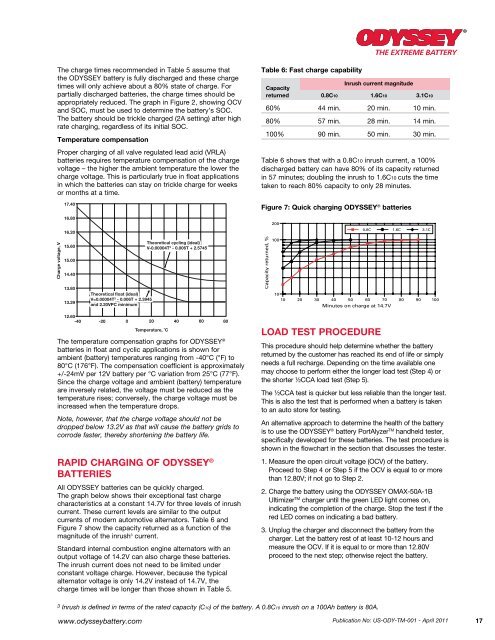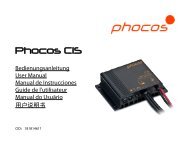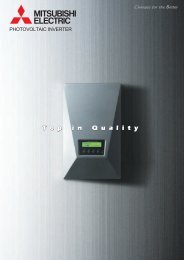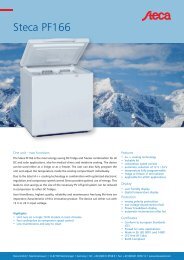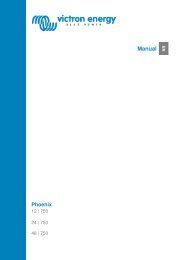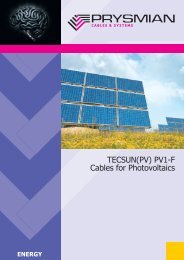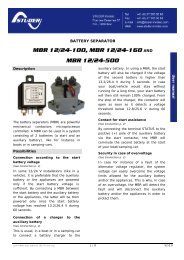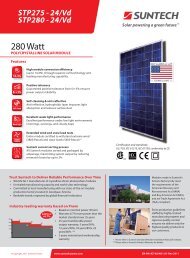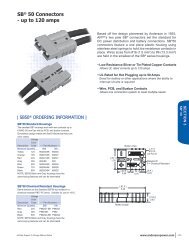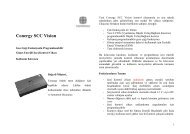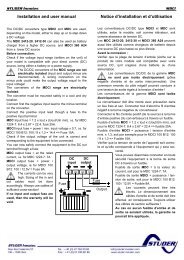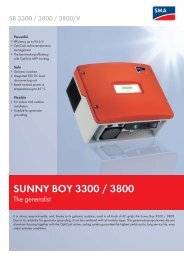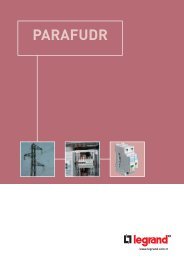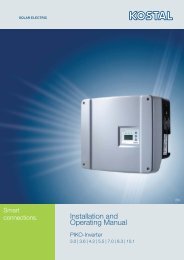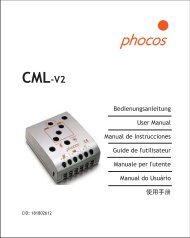Another class of chargers is designed specifically tomaintain a battery in a high SOC. These chargers, normallyin the 3 /4 amp to 1 1 /2 amp range, are not big enough tocharge a deeply discharged <strong>ODYSSEY</strong> ® battery. They mustonly be used either to continuously compensate for parasiticlosses or to maintain a trickle charge on a stored battery, aslong as the correct voltages are applied. It is very important,therefore, to ensure that the <strong>ODYSSEY</strong> battery is fullycharged before this type of charger is connected to it.Effect of undercharge in cycling applicationsProper and adequate charging is necessary to ensure that<strong>ODYSSEY</strong> batteries deliver their full design life. Generallyspeaking, a full recharge requires about 5% more amphours(Ah) must be put back in than was taken out. In otherwords, for each amp-hour extracted from the battery, about1.05Ah must be put back to complete the recharge.Cycling tests conducted on an <strong>ODYSSEY</strong> PC545 batterydemonstrated the impact raising the charge voltage from14.2V to 14.7V has on the cycle life of the battery. Theresults are shown in the graph below.Step 2 Charger type - automatic or manualThe two broad types of small, portable chargers availabletoday are classified as either automatic or manual. Automaticchargers can be further classified as those that charge thebattery up to a certain voltage and then shut off and thosethat charge the battery up to a certain voltage and then switchto a lower float (trickle) voltage.An example of the first type of automatic charger is one thatcharges a battery up to 14.7V, then immediately shuts off.An example of the second type of automatic charger wouldbring the battery up to 14.7V, then switches to a float (trickle)voltage of 13.6V; it will stay at that level indefinitely. Thesecond type of automatic charger is preferred, because thefirst type of charger will undercharge the battery.A manual charger typically puts out either a single voltage orsingle current level continuously and must be switched offmanually to prevent battery overcharge. Should you chooseto use a manual charger with your <strong>ODYSSEY</strong> battery, donot exceed charge times suggested in Table 5 below. It isextremely important to ensure the charge voltage does notexceed 15V.16.1(B) Selecting battery type on your chargerAlthough it is not possible to cover every type of batterycharger available today, this section gives the <strong>ODYSSEY</strong>battery user some general charger usage guidelines tofollow, after the charger has been qualified for use with thisbattery.Amp-hrs out13.811.59.26.9Sample 1Sample 2Sample 3Sample 44.62.3Samples 1 & 2: Given a 24hr CC charge @ 650mA prior to cycle 55, then resumed cyclingSample 3: Given a 24-hr CC charge @ 650mA at cycle 359, then resumed cyclingSample 4: Given a 24-hr CC charge @ 650mA at cycle 254, then resumed cycling00 50 100 150 200 250 300 350 400 450CycleSamples 1 and 2 were charged at 14.2V while Samples 3and 4 were charged at 14.7V. All batteries were dischargedat 2.3A until the terminal voltage dropped to 10.02V andcharged for 16 hours. In this particular test, a capacity of11.5Ah corresponds to 100% capacity and 9.2Ah is 80%of rated capacity and the battery is considered to havereached end of life at that point.The message to be taken from this graph is clear – in deepcycling applications it is important to have the chargevoltage set at 14.4 – 15.0V. A nominal setting of 14.7V is agood choice, as shown by the test results.(A) Selecting the right charger for your batteryQualifying portable automotive and powersport chargers foryour <strong>ODYSSEY</strong> battery is a simple two-step process.Step 1 Charger output voltageDetermining the charger output voltage is the most importantstep in the charger qualification process.If the voltage output from the charger is less than 14.2V ormore than 15V for a 12V battery, then do not use the charger.For 24V battery systems, the charger output voltage shouldbe between 28.4V and 30V. If the charger output voltage fallswithin these voltage limits when the battery approaches afully charged state, proceed to Step 2, otherwise pick anothercharger.In general, do not use either the gel cell or maintenance freesetting, if provided on your charger. Choose the deep cycleor AGM option, should there be one on your charger. Table5 below gives suggested charge times based on chargercurrents. To achieve maximum life from your <strong>ODYSSEY</strong>battery after completing the charge time in Table 5, werecommend that you switch your charger to the 2A tricklecharge position and leave the battery connected to the chargerfor an additional 6-8 hours. The trickle charge voltage shouldbe 13.5V to 13.8V.Table 5: Suggested charge times<strong>ODYSSEY</strong> ®Charge time for 100% discharged batteryBattery Model 10-amp charger 20-amp chargerPC310 1.28 hours 40 minutesPC535 2.25 hours 1.25 hoursPC545 2 hours 1 hourPC625 3 hours 1.5 hoursPC680 2.7 hours 1.5 hoursPC925 4.5 hours 2.25 hoursPC1200 6.75 hours 3.5 hours75-PC1230 & 75/86-PC1230 9 hours 4.5 hours25-PC1400 & 35-PC1400 10.5 hours 5.25 hours34-PC1500, 34R-PC1500,34M-PC1500, 34/78-PC1500 11 hours 5.5 hours& 78-PC1500PC1700 11 hours 5.5 hoursPC1220 & 65-PC1750 11 hours 5.5 hoursPC1800-FT Not Recommended 17 hoursPC1350, 31-PC215016 hours 8 hours& 31M-PC2150PC2250 20 hours 10 hours16 www.odysseybattery.comPublication No: US-ODY-TM-001 - April 2011
®The charge times recommended in Table 5 assume thatthe <strong>ODYSSEY</strong> battery is fully discharged and these chargetimes will only achieve about a 80% state of charge. Forpartially discharged batteries, the charge times should beappropriately reduced. The graph in Figure 2, showing OCVand SOC, must be used to determine the battery’s SOC.The battery should be trickle charged (2A setting) after highrate charging, regardless of its initial SOC.Temperature compensationProper charging of all valve regulated lead acid (VRLA)batteries requires temperature compensation of the chargevoltage – the higher the ambient temperature the lower thecharge voltage. This is particularly true in float applicationsin which the batteries can stay on trickle charge for weeksor months at a time.17.40Table 6: Fast charge capabilityInrush current magnitudeCapacityreturned 0.8C10 1.6C10 3.1C1060% 44 min. 20 min. 10 min.80% 57 min. 28 min. 14 min.100% 90 min. 50 min. 30 min.Table 6 shows that with a 0.8C10 inrush current, a 100%discharged battery can have 80% of its capacity returnedin 57 minutes; doubling the inrush to 1.6C10 cuts the timetaken to reach 80% capacity to only 28 minutes.Figure 7: Quick charging <strong>ODYSSEY</strong> ® batteries16.8016.20Charge voltage, V15.6015.0014.40Theoretical cycling (ideal)V-0.00004T 3 - 0.006T + 2.574513.8013.2912.60Theoretical float (ideal)V=0.00004T 3 - 0.006T + 2.3945and 2.20VPC minimumTemperature, ˚CThe temperature compensation graphs for <strong>ODYSSEY</strong> ®batteries in float and cyclic applications is shown forambient (battery) temperatures ranging from -40°C (°F) to80°C (176°F). The compensation coefficient is approximately+/-24mV per 12V battery per °C variation from 25°C (77°F).Since the charge voltage and ambient (battery) temperatureare inversely related, the voltage must be reduced as thetemperature rises; conversely, the charge voltage must beincreased when the temperature drops.Note, however, that the charge voltage should not bedropped below 13.2V as that will cause the battery grids tocorrode faster, thereby shortening the battery life.Rapid charging of <strong>ODYSSEY</strong> ®batteriesAll <strong>ODYSSEY</strong> batteries can be quickly charged.The graph below shows their exceptional fast chargecharacteristics at a constant 14.7V for three levels of inrushcurrent. These current levels are similar to the outputcurrents of modern automotive alternators. Table 6 andFigure 7 show the capacity returned as a function of themagnitude of the inrush 3 current.Standard internal combustion engine alternators with anoutput voltage of 14.2V can also charge these batteries.The inrush current does not need to be limited underconstant voltage charge. However, because the typicalalternator voltage is only 14.2V instead of 14.7V, thecharge times will be longer than those shown in Table 5.Load test procedureThis procedure should help determine whether the batteryreturned by the customer has reached its end of life or simplyneeds a full recharge. Depending on the time available onemay choose to perform either the longer load test (Step 4) orthe shorter ½CCA load test (Step 5).The ½CCA test is quicker but less reliable than the longer test.This is also the test that is performed when a battery is takento an auto store for testing.An alternative approach to determine the health of the batteryis to use the <strong>ODYSSEY</strong> ® battery PortAlyzer TM handheld tester,specifically developed for these batteries. The test procedure isshown in the flowchart in the section that discusses the tester.1. Measure the open circuit voltage (OCV) of the battery.Proceed to Step 4 or Step 5 if the OCV is equal to or morethan 12.80V; if not go to Step 2.2. Charge the battery using the <strong>ODYSSEY</strong> OMAX-50A-1BUltimizer TM charger until the green LED light comes on,indicating the completion of the charge. Stop the test if thered LED comes on indicating a bad battery.3. Unplug the charger and disconnect the battery from thecharger. Let the battery rest of at least 10-12 hours andmeasure the OCV. If it is equal to or more than 12.80Vproceed to the next step; otherwise reject the battery.3 Inrush is defined in terms of the rated capacity (C10) of the battery. A 0.8C10 inrush on a 100Ah battery is 80A.www.odysseybattery.comPublication No: US-ODY-TM-001 - April 201117


